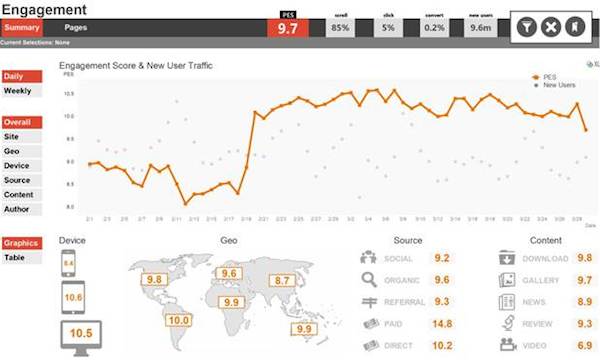Connect with execs from The New York Times, TIME, Dotdash Meredith and many more
‘The pageview is antiquated’: How Purch is trying to measure true reader impact

It’s no longer enough for publishers to have indiscriminate scale. But measuring whether readers like your site has always been tricky. It’s hard enough to figure out where people are coming from, what they’re reading and why they leave. And metrics can be abused, as anyone who’s clicked through a multi-page online slideshow knows.
Purch is trying to change all that. Purch is a network of 15 tech sites including Top Ten Reviews, Live Science and Tom’s Guide, with product review-driven e-commerce a core part of its business. The company is trying to replace the timeworn pageview with a new reader engagement score based on how deeply a reader goes with content.
”The age-old pageview metric seems very antiquated,” Purch CEO Greg Mason said. “[The engagement score] is just a more intellectually honest way to rally around what it’s going to take to get more engagement around a brand.”
Like a lot of publishers, Purch used to measure its success by looking at metrics including pageviews, pageviews per visit and repeat visits over a 30-day period. Now, using a combination of Google Analytics and technology created by its eight-person business intelligence team, Purch devised a score based on three metrics: how far the reader scrolled; if they clicked on the article or page; and most important, did they take an action such as signing up for a newsletter, sharing an article or clicking to buy a product.
The scoring is still rolling out across Purch’s sites. The idea is that editorial and product teams at the brands will review them on a daily basis, but all editorial staffers will have access to the data in a dashboard. Mason said editors are already getting a sense of what kind of content is yielding the best engagement — and didn’t rule out the possibility of using the scores to financially incentivize editorial staff.

The scoring system got its first test with Purch’s Space.com. The site had recently gotten some tweaks that helped it load faster. A spike in the site’s engagement score followed, which to Mason validated the new measurement approach. “We immediately saw the impact — with no ambiguity,” he said.
There are a couple of goals here. Since Purch derives so much of its revenue from commerce, its livelihood depends on its ability to push people down the purchase funnel. So it’s incumbent on the company to get more sophisticated about figuring out what’s working with readers.
Mason eventually plans to use the engagement score to demonstrate the value of its readers to advertisers and make the case for higher ad rates, too.
Marketers have an endless number of ways to reach consumers. Google and Facebook are increasingly sucking up more of the digital ad pie. Lucrative direct ad buys are under pressure as ad dollars are increasingly going to programmatic. Ad buyers are questioning the value of clicks. Publishers need to find a point of difference. For now, the engagement score is just being used in the newsroom, but Mason hopes to start making it a part of sales calls as early as next year.
“We’re at the end of that process where people are chasing clicks,” he said. “We felt for some time the metric had to change. You’ve started to see the cracks in the pillars.”
Purch isn’t the only publisher trying to move beyond the click. Medium, The Financial Times and Upworthy have long been touting the idea that time spent on site is more meaningful than how many people visited it. BuzzFeed is thinking about metrics that better reflect engagement. Millennial news site Mic is working on what it calls an “impact metric” that’s made up of things like scroll depth and time spent. In that vein, it’s added a reader survey to the bottom of articles that asks them to rate the story on a scale of 1 to 10, and will use those results to validate reader behavior data.
“We basically think pageviews are not important,” Mic’s chief strategy officer Cory Haik said. For now, the plan is to use the metric to help inform news decisions, but the idea is to use it to talk to advertisers about changing how they evaluate publishers. Already, Mic is putting similar surveys at the bottom of branded content to gauge its effectiveness, she said.
Selling new metrics to ad buyers who are invested in established buying practices is tricky, though. The term “engagement” is becoming somewhat of a cliche to advertisers that increasingly want to see that their ads drove business results. New metrics have their critics, too. “Any new-fangled measurement approach has to be vetted,” said Tom Talbert, head of media at Campbell Ewald.
More in Media

Three publishers’ workforce diversity reports show DEI efforts remain sluggish
Overall, staff diversity at The New York Times, Hearst and Condé Nast has either marginally improved or stalled in 2024, according to their annual workforce diversity data this year.

Retail media meets publishing: News UK, Future and Ocado tap clean room tech for smarter data targeting
News UK, The Independent, Immediate Media and Future are teaming up with retail media network Ocado to test clean room-powered data matching.

From sidelines to spotlight: Esports events are putting creators center stage
Esports events’ embrace of content creators reflects advertisers’ changing priorities across both gaming and the wider culture. In the past, marketers viewed esports as one of the best ways to reach gamers. In 2025, brands are instead prioritizing creators in their outreach to audiences across demographics and interest areas, including gaming.





